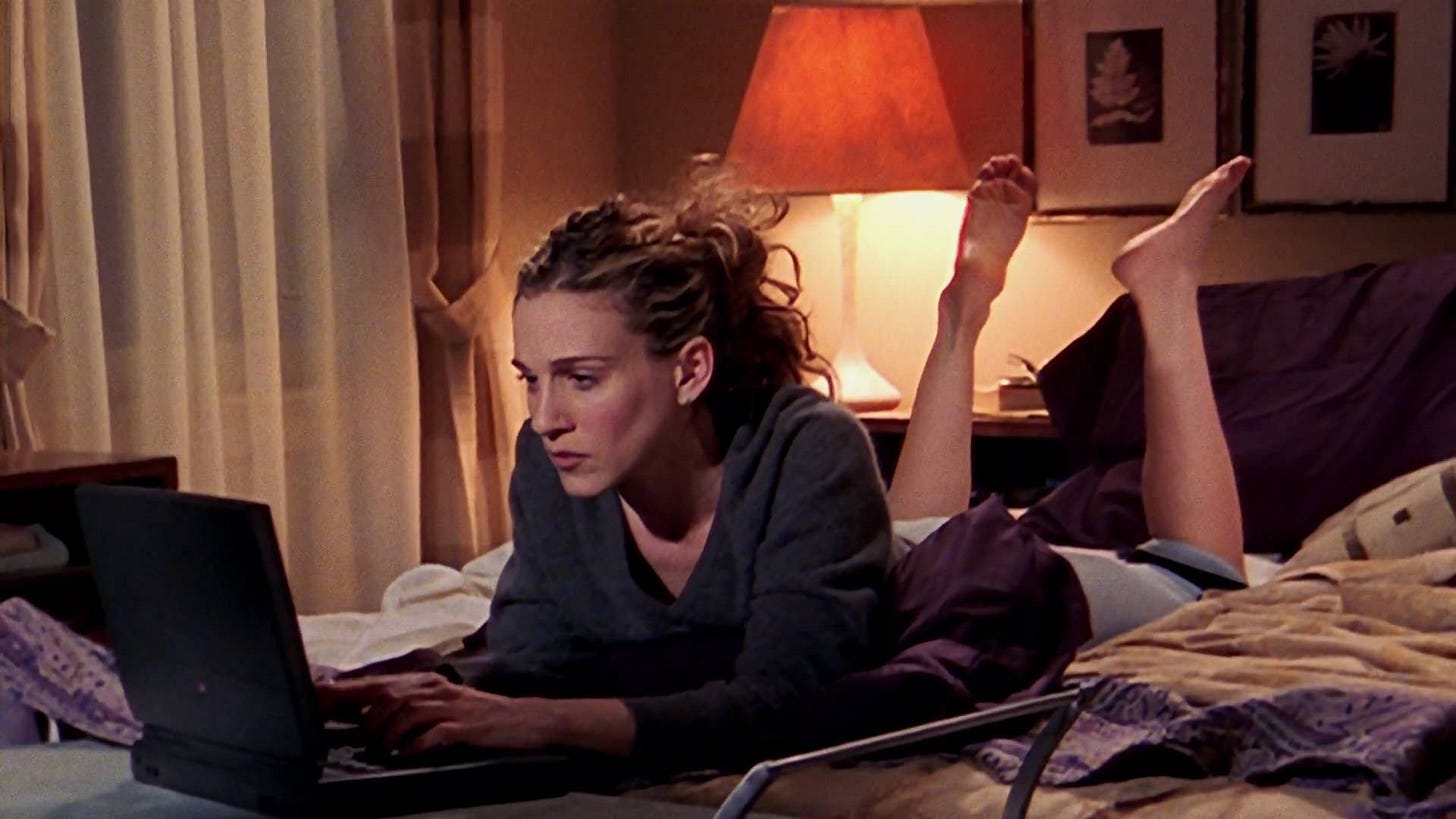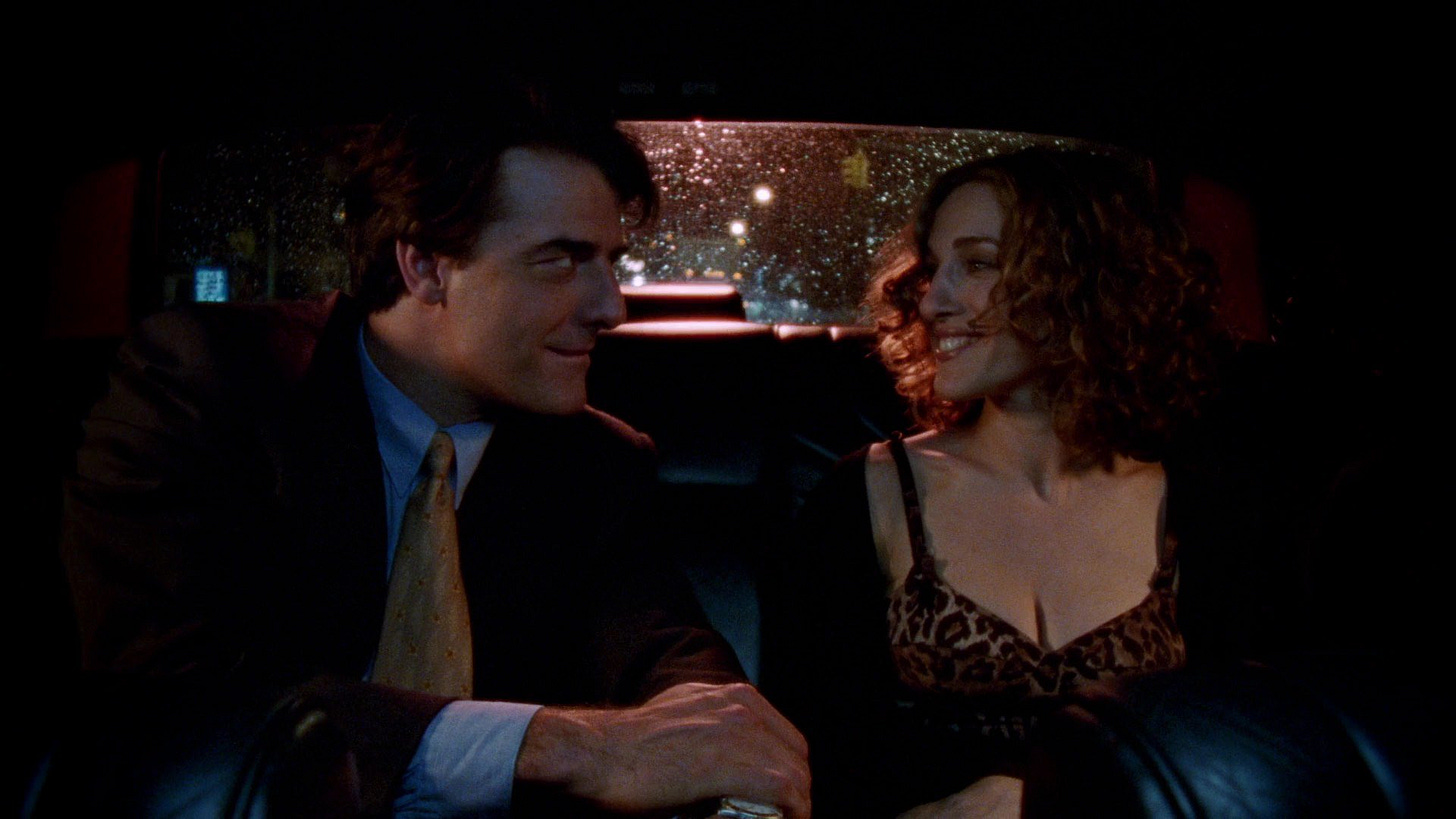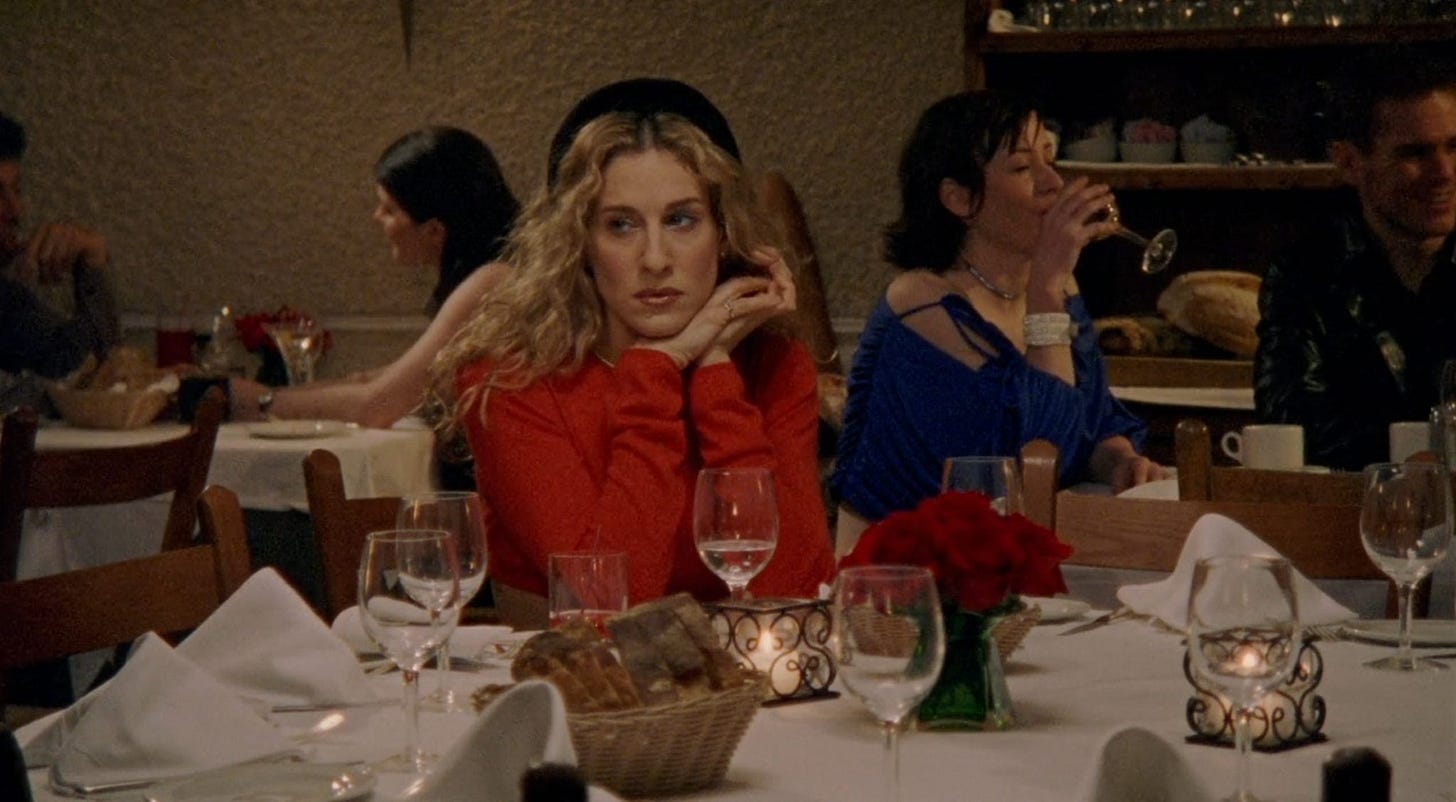I came to it young, a little over a decade ago, and have been rewatching it ever since. As a teenager, seeing Sex and the City for the first time, it was all about the clothes and all about the girls. The men seemed boring and ancient. At 13 or 14, they repelled and disgusted me. It was the four central female characters – Carrie Bradshaw, Samantha Jones, Miranda Hobbes and Charlotte York – who I was captivated by. In particular, I was drawn to the show’s protagonist – Carrie Bradshaw. Carrie, with her weekly sex column, her blonde curly hair and her Fendi baguettes, presented to me a certain vision of adult womanhood: glamorous and self-reliant, bolstered by warm, long-term, female friendships. It was a version of cosmopolitan female life that compelled me; I wanted to replicate it. With each episode of SATC I watched, idealistic images of an imagined adult future began to form.
SATC premiered in 1998 – the same year Bill Clinton was impeached over his affair with Monica Lewinsky, the same year Time Magazine asked ‘Is Feminism Dead?’ The series was adapted from Candace Bushnell’s New York Observer column of the same name, a series of vignettes about dating in New York, based on Bushnell's own romantic life and the lives of her friends. If there was some embarrassing romantic act that Bushnell didn’t want to admit to, she would anonymise the experience by inserting her “friend” and alter-ego into the column – Carrie Bradshaw.
The first season of SATC is grittier than the seasons that follow it, closer to the original material. Its one-liners are pithier and harsher: ‘Don’t listen to the dime-store Camilla Paglia’. The cultural references of Season 1 feel more localised to Bushnell’s cosmopolitan New York milieu; these references generalised as the show’s audience grew. The characters are more jaded and hard-edged than in later seasons, they present as sluttier and more brash. Broey Deschanel wonderfully describes them as ‘calcified by the harsh winds of New York’s dating culture.’ In very broad strokes, Seasons 1 and 2 of the show mostly follow Carrie Bradshaw’s on-again-off-again relationship with a man we only know as Mr. Big, an emotionally unavailable financier she is infatuated with. In Season 3, after ending the Mr. Big entanglement, she meets an opposing male archetype, a furniture designer named Aidan Shaw – ‘warm, masculine and classic American, just like his furniture’. He is loyal and emotionally open, the opposite of Mr. Big. Mid-way through Season 3, Carrie cheats on Aidan with Mr. Big (who is married at the time) and they begin an affair. In Season 4, Carrie begs for Aidan back and they resume their relationship. By the end of the season, Aidan has left Carrie because she cannot commit to him. Seasons 5 and 6 see Carrie repent for her sins, in an awful bob. In the final episode of the series, she leaves the Russian artist she has moved to Paris with and reunites with Mr. Big. The 6th and final season, in particular, I find borderline unwatchable. My temperament is generally tilted towards the sentimental. But even for me, those final two episodes – with their big poofy dresses and sappy monologues on love – stray too far into the ridiculous. This Hallmark-movie-style logic continues into the first film, turns offensive in the second film and curdles into something depressing and anaesthetised in the show’s latest offering And Just Like That.
Over drinks about a month ago, my friend Molly and I’s conversation turned to our shared, frequent rewatches of SATC. I suspect there might be something common to our temperaments that draws us both to the show so deeply and so consistently. Molly made the point that SATC is rewatchable in a way that Lena Dunham’s Girls, for example, isn’t. We agreed that Girls felt too dispiriting to demand repeated, regular viewing. And I couldn’t help but wonder (lol)… what makes SATC not only so compulsively watchable, but so rewatchable?
I experience (re)watching SATC as comforting and uplifting. I turn to it when I feel blue or jittery and it both calms and energises me, like a cigarette. This comfort can partly be attributed to my familiarity with the show. I feel some para-social intimacy with its characters and the plot lines are predictable, because I already know what happens! There are some episodes in Seasons 2 and 3 that I know so well that I can anticipate the dialogue before it arrives. This watchability can also be explained, in part, by the structure of each episode. Every episode of SATC is thematically united, pulled together by Carrie’s voiceover – full of pertinent questions like ‘are we sluts?’ This structure makes the storylines neat and satisfying. There are moments of sorrow and pain and abjection but the general tone of SATC is light. The show does not demand a great deal, intellectually, from its viewers.
I am travelling in Italy at the moment, writing this piece from Florence. Being in this country, with its luxury fashion houses and extremely stylish older women, has prompted me to think about glamour – its rituals, its power, its source – in a general sense. What is glamour? What are its contours; what drives it? Is it only shallow, only materialistic? And if that is the case, why does glamour mean so much to me? Why am I so struck when, walking down the street in Florence, I see a woman in her late fifties wearing all white, with blonde, blown-out hair and large Gucci sunglasses and bright red lipstick and a tiny, long-haired chihuahua? What makes that feel meaningful? Why does it move me to the extent that it does? Is it just evidence of my superficiality?
It is perhaps because of this context that, writing now, I wonder what role glamour might play in constructing the tone and world of SATC, in making it so very rewatchable. The glamour of SATC is partly why we might describe watching the show as ‘escapism.’ Watching the gorgeous, toned Carrie strutting around New York in Manolo strappy sandals or seeing the girls drinking cosmopolitans distracts us from the mediocrities and banalities of our own lives. The glamorous lifestyles of the show’s central characters are also aspirational. SATC makes us want. It prompts us to want a glamorous (expensive) life, to want to buy strappy sandals of our own. Would I have spent as many hours as I have on ebay looking for vintage Dior from the period John Galliano was creative director, if I hadn’t seen Carrie in that cowl-necked newspaper dress he designed for their 2000 Autumn-Winter collection?
I suspect the glamour of SATC isn’t only shallow and materialistic. I think that in SATC, glamour is defensive. For the four central characters, to be glamorous is to wield a small (sometimes ineffectual) shield against the indignities of contemporary, post-feminist life, especially life as a single woman over 30. In SATC, glamour is a ritualised mode of being, an elevation. This is not to say glamour is some utopia. But for Carrie in particular, glamour – however co-opted it may be by advertising and luxury and commerce, however far she may be into credit card debt – allows her to cultivate a playful relationship with the world around her. Carrie even says in the early seasons that shopping, for her, might be ‘a way to unleash the creative subconscious.’
In the later seasons and films, this principle of glamour becomes totally entwined with extreme wealth, unattainable for the viewer. As Candace Bushnell herself said in an interview with Jia Tolentino for The New Yorker, ‘Carrie Bradshaw ended up being a quirky woman who married a really rich guy.’ In the early seasons, Carrie’s relation to glamour is far more precarious. Something I sometimes forget about the first season in particular is that Carrie’s glitz is often borrowed, paid for with debt or on the dime of someone else. In the episode ‘The Power of Female Sex’, a Dolce and Gabbana store attendant is instructed over the phone by American Express to cut Carrie’s credit card in half. It is only when Carrie looks across the store and spots her ‘international party girl’ friend Amalita, with her latest wealthy beau (and his credit card), that she gets her hands on the fluffy heeled mules she is after. Later in the episode, the morning after Carrie confesses to a wealthy French architect that she has an expensive shoe “problem”, she wakes up in his hotel room with an envelope containing $1000 next to the bed.
The Carrie who takes the $1000 from the French architect after having sex with him is basically unrecognisable when compared to the prudish Carrie of the later seasons. By the final season of SATC, Carrie is more like the type-A, ballet-trained, uptight-seeming Sarah Jessica Parker than the shrewd and slightly jaded Candace Bushnell. I’m not the first to point out Carrie’s prudishness (she’s a sex columnist!) but, as an aside, I’d like to retrace some of her greatest hits. She shamed Samantha for blowing the World Wide Express guy, she freaked out when her date revealed his bisexuality, she condescended to her politician BF when he…very politely and without expectation…requested she piss on him and then leaked the details of this request in her column, she regularly refused to indulge even the most rudimentary of girl-talk questions at brunch and more and more.
The other reason SATC rewards repeated viewing is this: much of its younger audience first watched the series in our teens, a time when we were far away in experience from its characters. With each new experience – each break-up, each bad date, each friendship fracture – the show becomes new again. I see in SATC some (now) recognisable patterns of romantic behaviour that didn’t manifest at all in my teenage years. These patterns become more well-worn and obvious – in both myself and my friends – as I get older. That is not to say that all women who date men have interchangeable romantic experiences. It is also not to say these four characters are an indicative sample of the general population. Many viewers and critics have noted the particularly problematic elements of the show, as well as the narrow kind of experience — white, straight(ish), wealthy — that it limits itself to depicting, an oversight it tries to correct in And Just Like That with…mixed…results.
The episode ‘Attack of the Five-Foot-Ten Woman’, early in Season 3, opens with the four girls making fun of the New York Times wedding section over brunch. They turn the page to find an unexpected emotional bomb – the fluffy write-up of Mr. Big’s wedding to 26-year-old Natasha Nijinsky, a Ralph Lauren junior executive. After brunch, Charlotte follows Carrie home to make sure she is okay. Carrie insists she will be fine; Charlotte insists on staying. Sitting in Carrie’s apartment, they decide to go through the article together, with Charlotte reading aloud. At first, they mock the article for being overwritten and full of clichés. They get a few paragraphs in. Charlotte reads: ‘as she walked down the aisle, a saxophone played “When A Man Loves A Woman.”’ She adds: ‘Well that’s tacky!’ Carrie replies: ‘No, that’s Big.’ Carrie leans forward, puts her head into her hands and begins to cry, bending over herself in her chair. ‘It’s not him,’ Carrie says, ‘It’s the whole wedding. And it's her, her, her. She’s shiny hair, style section, Vera Wang and I’m the sex column they print next to ads for penile implants.’
Discussing this episode on their SATC rewatch podcast Sentimental in the City, Caroline O’Donoghue and Dolly Alderton commiserate over the fact that this moment always makes them both cry. It is a scene that predictably makes me cry, too. Even re-reading over the dialogue, I get a little misty. It is the moments of vulnerability and support in the central friendships of SATC that move me the most often in my rewatching. It is perhaps for this reason that rewatching SATC with friends, whether actually sitting and watching together or just discussing recently watched episodes, feels so cathartic. Perhaps this is also why podcasts like Sentimental in the City ring so true. In some of my closest friendships, SATC is a shared reference point that influences and enlivens the way we narrate our experiences of dating to each other. For me, SATC is not only a show about female friendship, it is a show that lives, still, in the shared language of my own female friendships.
I suppose part of the reason I am rewatching SATC at the moment is because I am “going through” a break-up. I’m not sure if “going through” is quite the right verb, even if it is a common one. I have been thinking about the ways that being in a relationship with someone can feel like building a world with them, some of it real, some of it imaginative, with a little bit of struggle on both sides for whose imaginative vision will win out. As the old Skeeter Davis song goes, when a relationship is over, it can feel like the world, too, has ended. The end of my relationship necessitated that I imagine a different kind of world, another kind of life. Now, I look for new models for living. In its familiarity and glamour, in its preferencing of female friendship, I suspect SATC is one such model.
Further reading
Sex and the City (HBO)
Sentimental in the City (podcast), hosted by Caroline O’Donoghue and Dolly Alderton
‘The Undoing: The Unusual, Unhappy “And Just Like That”’ by Philippa Snow in The LA Review of Books
Candace Bushnell Is Back in the City, Candace Bushnell interviewed by Jia Tolentino in the New Yorker
‘Carrie Bradshaw’ on Stargirl (podcast), hosted by Emma Glenn Baker, with Callie Hitchcock
Reading Sex and the City edited by Kim Akkas and Janet Mccab
Who’s Afraid of Carrie Bradshaw (video essay) by Broey Deschanel
Sex and the City: Love at the End of History (video essay) by Broey Deschanel
‘Is Feminism Dead?’ by Ginia Bellafante in Time Magazine (1998)
All the photos in this article are from Twitter user Hannah (@dumbandfunn), who has archived images from every episode of SATC











